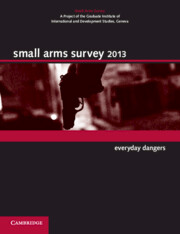Book contents
- Frontmatter
- Foreword
- Contents
- About the Small Arms Survey
- Notes to readers
- Acknowledgements
- Introduction
- Chapter 1 Everyday Dangers: Non-conflict Armed Violence
- Chapter 2 Too Close to Home: Guns and Intimate Partner Violence
- Chapter 3 Turning Points: Gang Evolution in Nicaragua
- Chapter 4 Guns in the Family: Mafia Violence in Italy
- Chapter 5 Survival at Stake: Violent Land Conflict in Africa
- Chapter 6 Trend Lines: Armed Violence in South Africa pages 132 to 137
- Chapter 6 Trend Lines: Armed Violence in South Africa pages 137 to 159
- Chapter 7 Second Wind: The PoA's 2012 Review Conference pages 160 to 168
- Chapter 7 Second Wind: The PoA's 2012 Review Conference pages 169 to 177
- Chapter 8 Trade Update: Authorized Small Arms Transfers
- Chapter 9 Burning the Bullet: Industrial Demilitarization of Ammunition pages 186 to 199
- Chapter 9 Burning the Bullet: Industrial Demilitarization of Ammunition pages 200 to 217
- Chapter 10 ‘Infernal Machines’: Improvised Explosive Devices
- Chapter 11 Price Watch: Arms and Ammunition at Illicit Markets pages 250 to 268
- Chapter 11 Price Watch: Arms and Ammunition at Illicit Markets pages 269 to 281
- Chapter 12 Captured and Counted: Illicit Weapons in Mexico and the Philippines pages 282 to 302
- Chapter 12 Captured and Counted: Illicit Weapons in Mexico and the Philippines pages 302 to 317
- Index
- Frontmatter
- Foreword
- Contents
- About the Small Arms Survey
- Notes to readers
- Acknowledgements
- Introduction
- Chapter 1 Everyday Dangers: Non-conflict Armed Violence
- Chapter 2 Too Close to Home: Guns and Intimate Partner Violence
- Chapter 3 Turning Points: Gang Evolution in Nicaragua
- Chapter 4 Guns in the Family: Mafia Violence in Italy
- Chapter 5 Survival at Stake: Violent Land Conflict in Africa
- Chapter 6 Trend Lines: Armed Violence in South Africa pages 132 to 137
- Chapter 6 Trend Lines: Armed Violence in South Africa pages 137 to 159
- Chapter 7 Second Wind: The PoA's 2012 Review Conference pages 160 to 168
- Chapter 7 Second Wind: The PoA's 2012 Review Conference pages 169 to 177
- Chapter 8 Trade Update: Authorized Small Arms Transfers
- Chapter 9 Burning the Bullet: Industrial Demilitarization of Ammunition pages 186 to 199
- Chapter 9 Burning the Bullet: Industrial Demilitarization of Ammunition pages 200 to 217
- Chapter 10 ‘Infernal Machines’: Improvised Explosive Devices
- Chapter 11 Price Watch: Arms and Ammunition at Illicit Markets pages 250 to 268
- Chapter 11 Price Watch: Arms and Ammunition at Illicit Markets pages 269 to 281
- Chapter 12 Captured and Counted: Illicit Weapons in Mexico and the Philippines pages 282 to 302
- Chapter 12 Captured and Counted: Illicit Weapons in Mexico and the Philippines pages 302 to 317
- Index
Summary
Many states are beset by forms of armed violence that do not rise to the level of armed conflict (war), but that nevertheless generate serious health, social, and economic consequences. In fact, non-conflict armed violence claims far more lives worldwide than do ongoing wars. But it is a complex phenomenon, involving a mosaic of actors driven by diverse motivations and conditions. Curtailing its many manifestations requires tailored interventions developed from a sound evidence base.
CHAPTER HIGHLIGHTS
The 2013 edition of the Small Arms Survey explores different aspects of non-conflict armed violence, focusing on some broad categories as well as specific countries and regions. Individual chapters highlight, wherever possible, improving or deteriorating conditions and existing knowledge concerning the underlying drivers and dynamics of armed violence in those environments. This volume emphasizes that, while successes exist, policy outcomes are more mixed in many other contexts.
In South Africa, for example, the introduction of stronger gun laws following the end of the apartheid era appears to have helped drive down gun homicides and non-fatal assaults, although rates still remain high by global standards (SOUTH AFRICA). Law enforcement pressure is similarly a factor in the significant reductions in armed violence committed by Italian mafia groups in recent years. For many such groups, the use of violence has simply become too risky (MAFIA VIOLENCE).
- Type
- Chapter
- Information
- Small Arms Survey 2013Everyday Dangers, pp. 1 - 5Publisher: Cambridge University PressPrint publication year: 2013



